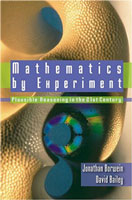|
|
|
The figure eight knot, also known as the Flemish knot and savoy knot, is the unique prime knot of four crossings 04-001. It has braid
word .
The figure eight knot is implemented in the Wolfram Language as KnotData["FigureEight"].
It is a 2-embeddable knot, and is amphichiral as well as invertible. It has Arf invariant 1. It is not a slice knot (Rolfsen 1976, p. 224).
The Alexander polynomial , BLM/Ho polynomial
, Conway
polynomial
,
HOMFLY polynomial
, Jones polynomial
, and Kauffman
polynomial F
of the figure eight knot are
|
(1)
| |||
|
(2)
| |||
|
(3)
| |||
|
(4)
| |||
|
(5)
| |||
|
(6)
|
There are no other knots on 10 or fewer crossings sharing the same Alexander polynomial, BLM/Ho polynomial, bracket polynomial, HOMFLY polynomial, Jones polynomial, or Kauffman polynomial F.
The figure eight knot has knot group
|
(7)
|
(Rolfsen 1976, p. 58).

Helaman Ferguson's sculpture "Figure-Eight Complement II" illustrates the knot complement of the figure eight knot (Borwein and Bailey 2003, pp. 54-55, color plate IV, and front cover; Bailey et al. 2007, p. 37). Furthermore, Ferguson has carved the BBP-type formula for the hyperbolic volume of the knot complement (discussed below) on both figure eight knot complement sculptures commissioned by the Clay Mathematics Institute (Borwein and Bailey 2003, p. 56; Bailey et al. 2007, pp. 36-38).
The hyperbolic volume of the knot complement of the figure eight knot is approximately given by
|
(8)
|
(OEIS A091518). Exact expressions are given by the infinite sums
 |
(9)
| ||
 |
(10)
| ||
 |
(11)
| ||
![(2pi)/3[1-ln(pi/3)+sum_(k=1)^(infty)(zeta(2k))/(k(2k+1)6^(2k))]](/images/equations/FigureEightKnot/Inline37.svg) |
(12)
| ||
 |
(13)
|
where
is a harmonic number.
has a variety of BBP-type
formulas including
![sqrt(3)sum_(k=0)^(infty)[1/((3k+1)^2)-2/((3k+2)^2)+4/((3k+3)^2)]](/images/equations/FigureEightKnot/Inline45.svg) |
(14)
| ||
![(3sqrt(3))/2sum_(k=0)^(infty)[1/((3k+1)^2)-1/((3k+2)^2)]](/images/equations/FigureEightKnot/Inline48.svg) |
(15)
| ||
![sqrt(3)sum_(k=0)^(infty)[1/((6k+1)^2)+1/((6k+2)^2)-1/((6k+4)^2)-1/((6k+5)^2)]](/images/equations/FigureEightKnot/Inline51.svg) |
(16)
| ||
![sqrt(3)sum_(k=0)^(infty)[2/((6k+1)^2)-3/((6k+2)^2)-1/((6k+5)^2)]](/images/equations/FigureEightKnot/Inline54.svg) |
(17)
| ||
![sqrt(3)sum_(k=0)^(infty)[1/((6k+1)^2)+3/((6k+4)^2)-2/((6k+5)^2)],](/images/equations/FigureEightKnot/Inline57.svg) |
(18)
|
with additional identities for coefficients of of the form
(E. W. Weisstein, Sep. 30, 2007). Higher-order
identities are
![V=(2sqrt(3))/(243)sum_(k=0)^infty1/(729^k)[(243)/((12k+1)^2)-(243)/((12k+2)^2)-(324)/((12k+3)^2)-(81)/((12k+4)^2)+(27)/((12k+5)^2)-9/((12k+7)^2)+9/((12k+8)^2)
+(12)/((12k+9)^2)+3/((12k+10)^2)-1/((12k+11)^2)]
=(2sqrt(3))/(177147)sum_(k=0)^infty1/(531441^k)[(177147)/((24k+1)^2)-(177147)/((24k+2)^2)-(236196)/((24k+3)^2)-(59049)/((24k+4)^2)+(19683)/((24k+5)^2)-(6561)/((24k+7)^2)+(6561)/((24k+8)^2)+(8748)/((24k+9)^2)+(2187)/((24k+10)^2)-(729)/((24k+11)^2)+(243)/((24k+13)^2)-(243)/((24k+14)^2)-(324)/((24k+15)^2)-(81)/((24k+16)^2)+(27)/((24k+17)^2)-9/((24k+19)^2)+9/((24k+20)^2)+(12)/((24k+21)^2)+3/((24k+22)^2)
-1/((24k+23)^2)]](/images/equations/FigureEightKnot/NumberedEquation3.svg) |
(19)
|
(E. W. Weisstein, Aug. 11, 2008).
Additional classes of identities are given by
![sqrt(3)sum_(k=0)^(infty)(-1)^k[1/((3k+1)^2)+1/((3k+2)^2)]](/images/equations/FigureEightKnot/Inline62.svg) |
(20)
| ||
![sqrt(3)sum_(k=0)^(infty)(-1)^k[1/((9k+1)^2)+1/((9k+2)^2)-1/((9k+4)^2)-1/((9k+5)^2)+1/((9k+7)^2)+1/((9k+8)^2)],](/images/equations/FigureEightKnot/Inline65.svg) |
(21)
|
with additional identities for coefficients of of the form
(E. W. Weisstein, Sep. 30, 2007). Another
BBP-type formula is given by
![(2sqrt(3))/9sum_(k=0)^(infty)((-1)^k)/(27^k)[9/((6k+1)^2)-9/((6k+2)^2)-(12)/((6k+3)^2)-3/((6k+4)^2)+1/((6k+5)^2)].](/images/equations/FigureEightKnot/Inline70.svg) |
(22)
|
is also given by the integrals
 |
(23)
| ||
|
(24)
| |||
 |
(25)
|
and the analytic expressions
|
(26)
| |||
|
(27)
| |||
|
(28)
| |||
|
(29)
| |||
|
(30)
| |||
|
(31)
| |||
|
(32)
| |||
|
(33)
|
(Broadhurst 1998; Borwein and Bailey 2003, pp. 54 and 88-92; Bailey et al. 2007, pp. 36-38 and 265-266), where is a generalized
hypergeometric function,
is the trigamma function,
is the dilogarithm and
is Clausen's integral.